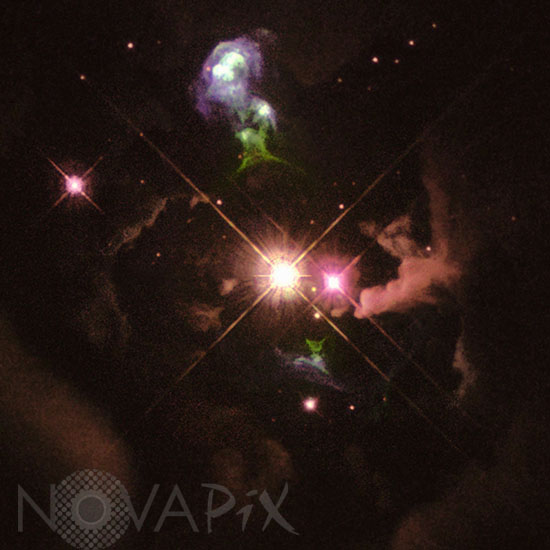Photo Agency - Astronomy - Space - Nature

HH 32 Herbig-Haro object
author: Nasa/Hubble Heritage team/Novapix
reference: a-eto50-00001
Image Size 300 DPI: 11 * 11 cm
HH 32 in Aquila constellation, is a "Herbig-Haro object," which is formed when young stars eject jets of material back into interstellar space. It is located at about 1,000 light-years from Earth. The wind from the bright central star has already cleared much of the dust out of the central region, thus exposing the star to direct view. Many young stars, like the central object in HH 32, are surrounded by disks of gas and dust that form as additional material is attracted gravitationally from the surrounding nebula. A fraction of the gas, however, is ejected perpendicularly to the disk at speeds near 200 miles per second, and forms two oppositely directed jets. These jets plow into the surrounding nebula, producing strong shock waves that heat the gas and cause it to glow in the light of hydrogen atoms (green) and sulfur ions (blue), several other atoms and ions, and sometimes radiation from the exciting star that is reflected by the surrounding gas (red). This glow is called a Herbig-Haro object, in honor of astronomers George Herbig and Guillermo Haro, who did much of the early work in this area in the 1950's. The jet on the top side, whose furthest extent is about 0.2 light-year from the star, is pointed more nearly in our direction, while the opposite jet on the bottom lies on the far side of the star and is fainter either because it is partially obscured by dust surrounding the star or because there is much less material in front of the star. Image made by Hubble space telescope in August 1994.
Keywords for this photo:
1994 - AQUILA - ASTRONOMY - EVOLUTION - FORMATION - HERBIG-HARO - HH 32 - HST - HUBBLE SPACE TELESCOPE - NEBULA - STAR - STAR FORMATION - YOUNG STAR -
Contact : Stéphane Aubin +33-(0)9-51-26-53-76
© Novapix - All rights reserved


